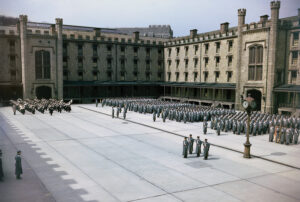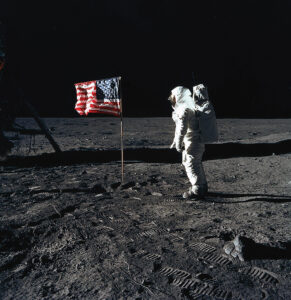The task went to Brig. Gen. Francis T. Dodd, Eighth Army deputy chief of staff, reassigned to command Koje-do Camp One with Col. Maurice J. Fitzgerald as his deputy. Dodd’s staff drafted a plan, Operation Spreadout, which would send an estimated 82,000 POWs and civilian internees to new camps on the mainland and to Cheju-do Island. Dodd thought that screening would be inevitably violent and didn’t think it could be done quickly, but that the screening could be supported by promises to protect the anti-Communist POWs.
On March 13, resisters in Compound 76 stoned a passing work detail. South Korean guards fired, killing 12 and wounding 26. In trying to stop the shooting, a Korean indoctrination program staffer and a U.S. Army officer were wounded. The entire U.S. 38th Infantry regiment then joined the guard force because of intelligence assessments that the Communists wanted to destroy the screening process with a mass jailbreak. Yet Ridgway rejected Van Fleet’s request to postpone screening. Instead, he ordered strict new controls on the indoctrination program and on the activities of Chinese nationalist agents. He also wanted recommendations on reducing the South Korean guard force, Korean service personnel, and refugees at Koje-do.
The screening began April 8 in the 11 compounds deemed most friendly. On April 10, however, Koreans in Compound 95 captured a medical party, and South Korean soldiers armed with clubs had to rescue them. The melee spread when other South Korean soldiers opened fire on the mob. A U.S. Army officer with a jeep-mounted machine gun stopped a rush to the gate. Three POWs died, and 60 fell wounded while one South Korean soldier disappeared and four were wounded. Operation Spreadout started separating repatriates from those preferring not to return. In command of the entire POW system, General Yount began moving the Koreans who refused repatriation from Koje-do to mainland camps at Pusan, Masan, Yongchon, Kwangju, and Nonsan. The captive Chinese, divided into repatriates and nonrepatriates, would be sent to new camps on opposite sides of Cheju-do Island.
Heavily protected, the UN Command screening teams worked their way through 22 of 28 compounds not firmly under Korean Communist control. They deemed six compounds-four North Korean army compounds and two for Communist Party members and guerrillas from all over Korea-to be too well-armed, well-organized, and belligerent to enter until the prospective battlefield had been cleared of all nonrepatriates and refugees. The nonrepatriate Chinese left the island first for Cheju-do, many unhappy they were not headed to Formosa. Some 7,000 Chinese POWs who wanted to go home to their families were left behind, only a few of them Communists.
By April 19, 1952, General Dodd’s teams had screened 106,376 POWs and civilian internees. Of these, 31,244 chose to return to Communist custody, while 75,132 preferred being sent to South Korea, Formosa, or elsewhere. Screening at the 64th Field Hospital in Pusan shows the strength of the resistance movement there: 4,774 POWs wanted repatriation; 1,738 did not.
Forwarding Dodd’s report to Washington, Ridgway warned that the Koje-do guard force still faced 43,000 violent, vicious North Korean resisters in six compounds: 37,628 POWs commanded by colonels Lee and Hong and 5,700 civilian internees directed by the mysterious, unidentified Mr. Pak. Yet many POWs had already been shipped from Koje-do to Pusan, Masan, Yongchon, Kwangju, Nonsan, and Cheju-do. It appeared Operation Spreadout was nearing completion in relative peace.
But this progress on nonrepatriates galvanized the resistance leaders to take desperate action in May 1952. Whether the resistance leaders received specific directions from General Nam is unclear, although reporters Winnington and Burchett later claimed that Pak, Lee, and Hong acted without orders, which brought them disgrace. The Koje-do Three-as Pak, Lee, and Hong came to be known-decided to kidnap General Dodd and force him to confess to mistreating the Communist POWs. At a minimum, they expected to create a media sensation and win a propaganda victory. Perhaps there would be a breakout. The plotters could also assume that they still had informers in their midst, requiring them to move quickly.
On April 29, the North Korean officers of Compound 76 asked to meet with Lt. Col. Wilbur Raven, a military police officer and enclosure commander. The meeting was supposedly to resolve Raven’s suspension of a cigarette ration after North Korean army officers refused to serve on work detail. Raven and a South Korean interpreter entered the “headquarters” hut just inside the wire and began listening to a barrage of demands. Suddenly more than a hundred cadremen flooded the building. They screamed at Raven and one tried to force-feed him bean soup. Then the POWs produced an EE8 field phone and told him to call General Dodd. After Raven passed on the prisoners’ demands-which Dodd rejected-the POWs released Raven. The whole bizarre episode was a rehearsal.
On May 7, the diehards of Compound 76 seized General Dodd. Responding to another POW request to discuss prison conditions and screening, Dodd and Raven met a delegation at the compound’s front gate. Discussions through the outer wire lasted more than an hour. Dodd, following Raven’s advice, was unarmed but armed GIs protected him. Then a “honey bucket” crew came by and a guard opened the outer gate. With a yell, POWs grabbed Dodd and almost captured Raven, who grabbed a gatepost and kicked his assailants away until the guards rescued him. As he was being carried away, Dodd ordered his soldiers not to shoot. None did.
The Dodd affair-called a mutiny by Western writers-threw unwelcome light on the UN Command’s POW management and the voluntary repatriation policy. It occurred as General Ridgway was turning over the Far East and UN Commands to Gen. Mark W. Clark. Ridgway ordered the use of “whatever degree of force” necessary to gain Dodd’s release. His demand to turn over Dodd was met with catcalls when read to the POWs. The next day a new Koje-do commander, Brig. Gen. Charles F. Colson, arrived with an American infantry battalion. An able, decorated infantry commander of World War II, Colson warned the POWs not to harm Dodd, his friend. He deployed all his infantry and mounted machine guns to deter a mass jailbreak, predicted by Dodd’s G-2.
Dodd reported his status to Colson, first by notes and later by telephone. His captors were treating Dodd with respect, but he found himself discussing prison reform, repatriation policy, and capitalist injustice-with his release at stake. The POWs also threatened him with a “trial” as a war criminal. The Communists placed festive protest signs around Compound 76 warning that Dodd would die if Colson tried to rescue him.
In May 9, Van Fleet, the Eighth Army commander, came to Koje-do to review the plans to break Compound 76’s resistance and save Dodd, though the latter was a secondary concern. The general had company: Ridgway and Clark. Both urged Van Fleet to give the POWs plenty of opportunity to surrender. They agreed there would be no media coverage of the Koje-do crisis. The critical matter, they thought, was massing firepower to neutralize the 19,000 POWs outside the hard-core Compounds 76, 77, and 78. Only then would American soldiers enter Compound 76, using tear gas and other riot-suppression equipment.
Van Fleet gave Colson another day for negotiations. Company B of the 64th Tank Battalion, 3rd Infantry Division, had not arrived from the mainland with its 22 tanks, including five flamethrower tanks. General Van Fleet also knew, however, that generals Ridgway and Clark wanted the Koje-do problem to disappear.
For reasons that are unclear, Ridgway did not tell Clark of Dodd’s capture until May 8. Ridgway knew that whether Dodd lived or died, the Communists would probably fight relocation, and he knew they were prepared to die in large numbers, which could not be kept secret. Ridgway may have preferred to let the inevitable massacre occur on Clark’s watch, because Ridgway wanted to be U.S. Army chief of staff. Clark wanted to retire.
Not briefed about the POW rebellion on his way to Tokyo, Clark was dismayed by the Koje-do surprise, which he called “the biggest flap of the entire war.” After negotiations the next day with the captors and several telephone conversations with Dodd, the two American brigadier generals made a deal. Eventually the Koje-do Three accepted a signed statement by General Colson that United Nations guards had killed and wounded “many prisoners of war.” Colson promised to “do all within my power” to treat the POWs according to international law; he said he had no authority to modify the UN Command position on voluntary repatriation.
He promised he would conduct no more “forcible” screening sessions, nor would he force nonrepatriates to again bear arms, and he would recognize POW representatives chosen by the POWs themselves. At nine thirty in the evening on May 10, Dodd walked out of Compound 76, unharmed. He and Colson were not, however, out of harm’s way.
Always public relations-conscious, Clark wanted Ridgway to explain the crisis to the press, but Ridgway issued no statement until May 12, when Clark coaxed him to approve a memo Clark’s staff had prepared, announcing that Dodd had bought his freedom two days earlier with what amounted to a confession of war crimes that implicated Ridgway and Van Fleet. Colson had signed the statement only to recover Dodd.
General Clark immediately disavowed Colson’s “confession” and produced an account he and Ridgway had agreed on even before Van Fleet and Dodd talked to the press in Seoul. Clark’s statement, however, revealed such a degree of ignorance of conditions on Koje-do that he could have been judged either a fool or a liar by anyone who knew about the events, including newsmen. For example, Clark claimed that the POW violence had been exaggerated and had no bearing on the armistice negotiations, when clearly they were central to those meetings.
[continued on next page]




